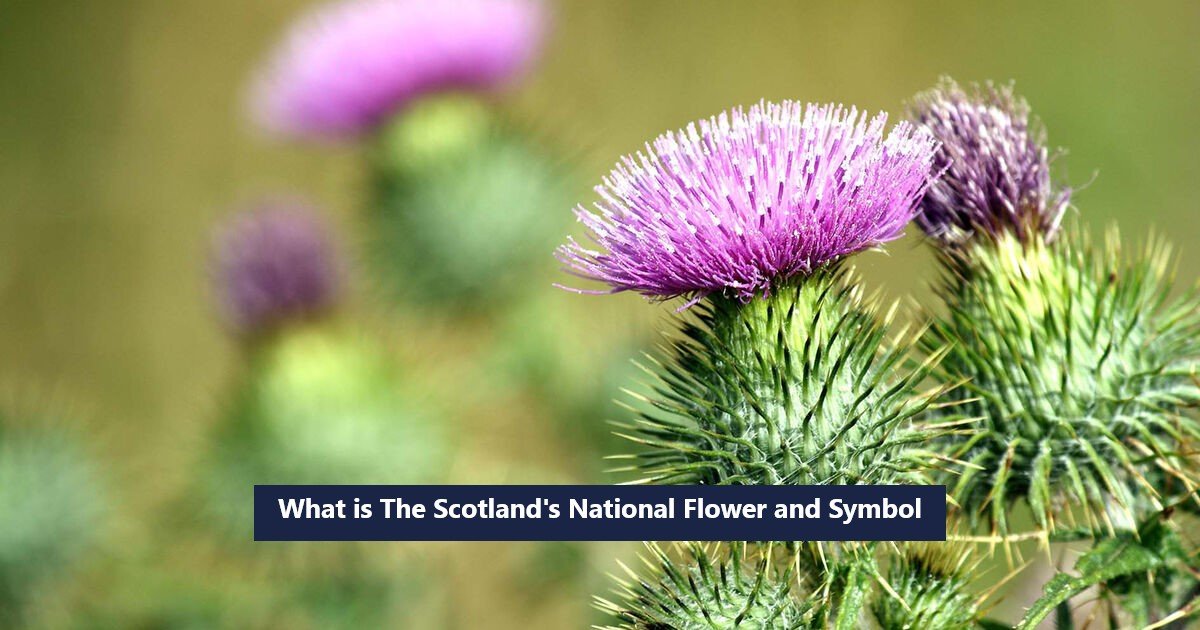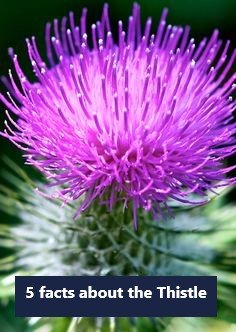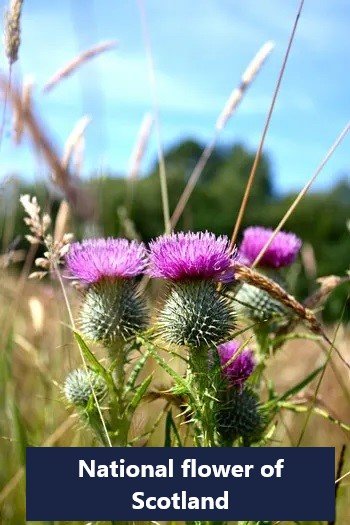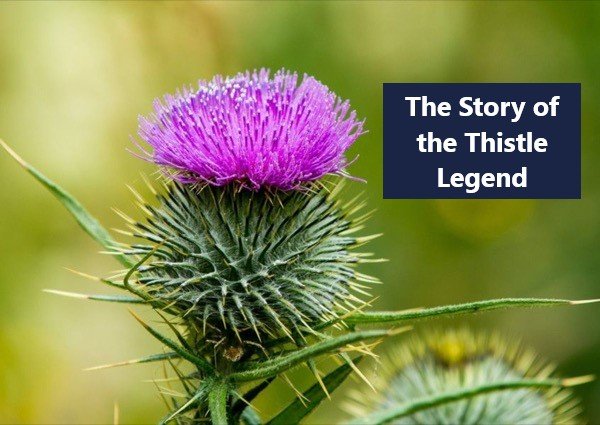What is The Scotland’s National Flower and Symbol

Nothing quite says ‘Scotland’ like this humble, prickly weed, second only to tartan. But how in the world did it end up being the proud symbol of a whole country?
Scotland is a nation rich in culture and history, and the thistle is its national symbol. It stands for its distinct and tenacious spirit. The cultural significance, history, and folklore surrounding Scotland’s national flower are all covered in this article. We cordially invite you to accompany us as we delve into the intriguing realm of the Scottish thistle.
5 facts about the Thistle
Mysterious origins
Nobody is quite sure how the Thistle with purple flowers became so important. However, according to a legend, a group of sleeping Scots warriors were spared from an impending Norse army ambush when one of the adversaries stepped on the spiky plant. His cries of agony awoke the sleeping warriors, who defeated the invader and made the Thistle their national emblem.

The evidence completely disproves this account, but it still makes for an engaging narrative.
More than one
There are multiple Thistle varieties found in Scotland; some are native, while others are exotic. It needs to be clarified which variety is the official emblem of Scotland. Which is it, Musk Thistle or Spear? Or is it Our Lady’s Thistle or the lyrically named Melancholy Thistle? What about the Thistle of Cotton?
Which might it be? We’ll accept your guess as well.
The poetry is inspired
The Thistle is the subject of one of the best-known and most influential poems in the canon of Scottish literature, Hugh MacDiarmid’s A Drunk Man Looks at the Thistle. Forget Rabbie Burns’ A Red, Red Rose, his ode to romantic love. This epic poem explores a wide range of topics, including the happiness of whisky, the state of the country, and the secrets of the cosmos.
An Honorable Badge
The thistle has been a significant emblem in Scottish heraldry for over five centuries. It also stands for one of the greatest honors a person can receive from their nation. The Most Ancient and Noble Order of the Thistle is an order of chivalry established in 1687 by James VII and II and is given to individuals who have significantly improved the quality of life in Scotland and the United Kingdom as a whole. HM The Most Noble Order of the Garter is the highest order in precedence, and only the King may invest members of the Order of the Thistle.

It is Ubiquitous
Not only can one find thistles in gardens, parks, and rural areas. If you keep your eyes open, you will notice the insignia emblem in Scotland. See how many you can identify, from the uniforms of police officers to local businesses, large organizations, and corporations to the strip of international rugby teams and football clubs.
The Story of the Thistle Legend
Legend has it that the thistle was initially connected to Scotland during a surprise Norse invasion at night. A warrior attempted to approach the Scottish soldiers from behind but stepped on a stinging thistle and let out a pained cry, alerting the other warriors. The Norse were defeated due to this abrupt turn of events, and the thistle came to represent caution.

Embracing endurance and resilience: Thistles’ capacity to endure in hostile environments is a metaphor for the Scottish people’s ability to persevere in the face of hardship. The thistle’s resilience symbolizes Scotland’s steadfast spirit, which persists in adversity.
Traditions and Their Cultural Significance
An adored symbol deeply ingrained in Scottish culture is the Scottish thistle. It is present in a lot of customs and celebrations. For centuries, the thistle has been a widely recognized symbol in Scotland. Both Highland Games and traditional Scottish artwork display it.
Relationships with Royals
The significance of thistles extends beyond folklore. With its strong association with Scottish Royalty, thistles are frequently seen on ceremonial regalia and Scottish Crown Jewels. This royal support bolsters the thistle’s standing as a national emblem.
A Flower of Pride
The vivid purple blooms of thistles create a fantastic display of color across the Scottish landscape. This yearly occasion is a lovely way to remember Scotland’s national flower and its breathtaking surroundings.

Discover the Variety of Thistles: Scotland is home to many thistle species. Among the most well-known is the Scottish thistle. These plants are a component of Scotland’s biodiversity and ecosystems.
The Contemporary Thistle
In Scotland nowadays, the thistle is a widely used symbol found on uniforms, flags, and official emblems. Generations have been inspired and connected by Thistle’s everlasting appeal. It promotes a feeling of cohesion and inclusion.
Were you aware?
In 1470, James III introduced the thistle as a royal symbol on silver coins. “Nemo me impune lacessit” is the Latin motto of the Order of the Thistle, meaning “no one attacks me with impunity.”
Conclusion
The humble but hardy thistle, Scotland’s national flower, represents the country’s past, present, and future. The thistle represents Scotland’s diverse cultural heritage, from old tales of defense to modern festivities. The next time you see a thistle in bloom, remember the journey of resilience, pride, and unity it symbolizes.
Frequently Asked Questions (FAQs)
Is the thistle the only national symbol of Scotland?
Scotland’s primary national symbol is the thistle, with the mythical lion rampant serving as its secondary emblem.
Are thistles found anywhere besides Scotland?
There are thistles everywhere in the world. But the Scottish thistle has a unique cultural significance.
How best can thistle be incorporated into an event with a Scottish theme?
Thistle decorations can be used as invitations or as decorations for your wedding.
What customs surround the thistles that are in bloom?
Although thistle blooming is not a formal tradition, it frequently corresponds with a sense of hope and pride in local communities.
Can you grow thistles in your garden?
You can grow a lot of thistle plants in gardens. Their hardiness, though, might call for particular circumstances.
How can I learn more about the past of the Scottish Thistle?
A deeper understanding of the Scottish Thistle’s history and symbolism can be gained by studying historical records, folktales, and other cultural materials.

